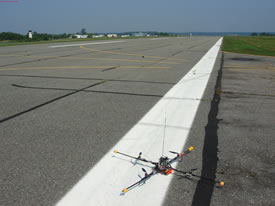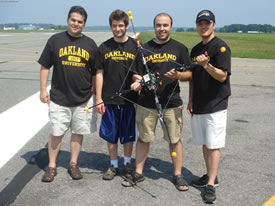
 |
| Oakland University’s newly formed Aerial Systems student organization participated in the Association for Unmanned Vehicle Systems International’s Student Unmanned Aerial Systems competition in Maryland in June. (Photo courtesy of Osamah Rawashdeh) |
By Rebecca Wyatt Thomas, OU Web Writer
Oakland University’s newly formed Aerial Systems student organization made its way to the Association for Unmanned Vehicle Systems International’s Student Unmanned Aerial Systems competition in Maryland in June. The four students involved designed and built a quad-rotor flying apparatus. When they got to the competition, even the judges questioned the ability of the contraption to work. However, the OU vehicle performed well, taking fifth place in the competition and placing ahead of schools such as Embry Riddle Aeronautical University and UCLA.
OU’s team was assembled by Assistant Professor of Engineering Osamah Rawashdeh, who participated in the competition with a team at the University of Kentucky in the past.
Usually, teams in the competition buy a pre-made airplane and program it to fit the competition. The students from OU decided to build their own. They designed an aircraft that looks like a pair of crossed sticks.
“With the four-propeller system, our vehicle takes off vertically and lands vertically,” said Rawashdeh, who serves as the Aerial Systems Club faculty adviser.
The goal of the competition was to build an aircraft that takes off, flies autonomously and finds target points on the ground.
Ermal Gjoni, an electrical engineering student, said it was challenging to put the vehicle together because all of the team members were electrical engineering or computer science students with no aerial systems background.
“We had the idea to build a quad-rotor system. We worked with an early prototype and from then on it has been a series of trial and error,” Gjoni said.
 |
|
Usually, teams in the competition buy a pre-made airplane and program it to fit the competition. The students from OU decided to build their own. They designed an aircraft that looks like a pair of crossed sticks. (Photo courtesy of Osamah Rawashdeh) |
“We promised the judges that next year, we’d surprise them with an even stranger design,” Gjoni said.
Hong Yang, electrical engineering student, said they want to make the vehicle fold up for easy transportation.
“What we accomplished wouldn’t have been possible without our education,” Hong said.
The students applied what they had learned in class, used research techniques and developed the flying apparatus with virtually no experience in the field.
“We competed against other universities that are better known for this type of engineering, with much larger budgets, and we did well,” Gjoni said. Other team members include Rami Abousleiman, a graduate student in electrical engineering, and Dan Korff, a computer science graduate.
While at the competition, the team members were also able to network with individuals from well-known aerial systems corporations include Raytheon Corporation and The Boeing Company.
Gjoni and Hong said the group was formed in the past year and they worked long days and late nights to complete it in time, but the team had a good time doing it.
“We’re truly all about learning. Everybody had to learn the entire process and since there were only four of us, we had to support each other. Having this experience and this knowledge is making us very competitive in the industry,” Gjoni said.
The Aerial Systems Club was supported by funding from the Center for Student Activities and the School of Engineering and Computer Science.
For more information on the Aerial Systems Club, or to get involved, contact Rawashdeh at rawashd2@oakland.edu .
 Oakland University’s newly formed Aerial Systems student organization made its way to the Association for Unmanned Vehicle Systems International’s Student Unmanned Aerial Systems competition in Maryland in June. The four students involved designed and built a quad-rotor flying apparatus. When they got to the competition, even the judges questioned the ability of the contraption to work. However, the OU vehicle performed well, taking fifth place in the competition and placing ahead of schools such as Embry Riddle Aeronautical University and UCLA.
Oakland University’s newly formed Aerial Systems student organization made its way to the Association for Unmanned Vehicle Systems International’s Student Unmanned Aerial Systems competition in Maryland in June. The four students involved designed and built a quad-rotor flying apparatus. When they got to the competition, even the judges questioned the ability of the contraption to work. However, the OU vehicle performed well, taking fifth place in the competition and placing ahead of schools such as Embry Riddle Aeronautical University and UCLA.